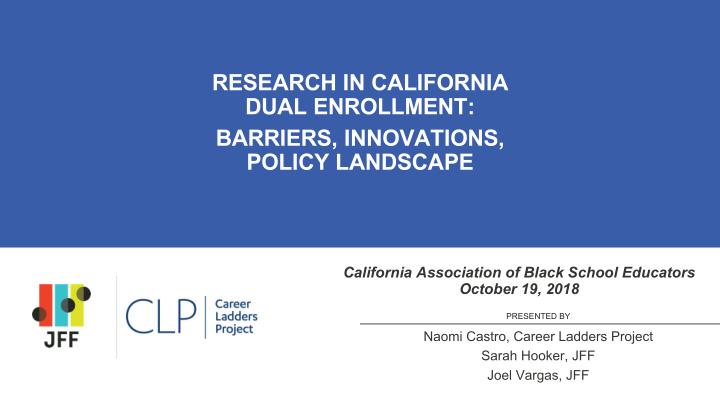



RESEARCH IN CALIFORNIA DUAL ENROLLMENT: BARRIERS, INNOVATIONS, POLICY LANDSCAPE California Association of Black School Educators October 19, 2018 PRESENTED BY Naomi Castro, Career Ladders Project Sarah Hooker, JFF Joel Vargas, JFF
The American labor market is broken. Our rapidly changing economy demands skilled and adaptable workers, but many people lack the education and training employers require. JFF is transforming the workforce and education systems to accelerate economic advancement for all. JFF designs innovative solutions, scales proven programs, and influences industry action and policymaking to drive the most transformative impact.
Career Ladders Project fosters educational and career advancement through research , policy initiatives and direct assistance to community colleges and their partners.
About Our Research California’s Dual Enrollment Landscape CLP Research Findings: Institutional Challenges and Bright Spots JFF Research Findings: System-Level Barriers and Examples from Other States A Proposed Agenda for Advancing Dual Enrollment in CA: Your Input and Feedback
RECENT RESEARCH PROJECTS DUAL ENROLLMENT RESEARCH QUESTIONS 1. What did dual enrollment look 3. What barriers do like in CA on the cusp of AB schools/colleges continue to have 288? with respect to expanding high- quality dual enrollment? 1. What did AB 288 attempt to solve? 4. What experiences from other states could be instructive for CA?
COMMUNITY COLLEGE RESEARCH CENTER PRESENTATION TITLE IN HEADER / JUNE 8, 2012 6
COMMUNITY COLLEGE RESEARCH CENTER PRESENTATION TITLE IN HEADER / JUNE 8, 2012 California: Highest Outcomes in Six Years by Income Among Students Who Participated in Dual Enrollment at Age 17 and First Matriculated at a Community College at Ages 18–20 Fink, Jenkins, & Yanagiura, 2017, 7 Further analysis of NSC data by authors
TWO TYPES OF DUAL ENROLLMENT IN CA CCAP (AB 288) Non-CCAP Districts & district • Schools & colleges • Closed classes • Open classes • Students who are underrepresented & • Advanced scholastics & vocational may not go to college • MIS + data sharing • MIS • Pathways • Random acts or planned - CTE - Transfer - HS graduation - College & career readiness
CURRENT STATE OF DUAL ENROLLMENT IN CA • Majority of students come to the college on their own • Slow uptake of AB 288; less anxiety around compliance • Implementation challenges, as infrastructure, staffing and practice issues not addressed • Expansion provides innovation and “bright spots” – Deepening of partnerships – Holistic, structured programs with integrated supports; – Rethinking the college culture and who is a college student – Focus on underrepresented students and their families
CLP FINDINGS 48 COLLEGES: • Data collection & enrollment • Integration • Capacity & implementation • Uncertainty about commitment at state level • Underserved youth • Uncertainty about new funding • Student services formula • Growth with quality http://www.careerladdersproject.org/ dual-enrollment-landscape/
Mentimeter - poll #1
CLP FINDINGS GOOD NEWS: • Colleges and high schools • Reedley innovating – robust pathway – district dual enrollment • CCAP seen as just one tool committee among many – data sharing for intervention • Commitment of leadership = • East Los Angeles strong partnerships – community asset model – adult ed + dual enrollment • Thoughtful pathways designs leading to certificates, degrees and transfer
JFF RESEARCH SYSTEMS-LEVEL BARRIERS IN CA • Lack of a common framework for defining best practices and validating program quality • Lingering worries about “double dipping” • Lack of coherent, coordinated state-level college completion agenda • Collective bargaining concerns
MENTIMETER - POLL #2
JFF RESEARCH PROMISING PRACTICES AND POLICY LESSONS: OTHER STATES • High-level leadership/vision • “Hold harmless” funding policies - Governor’s office support - Based on analysis of long-term cost benefits for the state • Dual enrollment as part of statewide college and career success strategic plans • Meaningful HS teacher- college faculty engagement - Shared roles for program design • Framework for quality control and best and quality assurance practices - NACEP standards; - Pathway requirements
A PROPOSED AGENDA KEY CONDITIONS FOR ADVANCING DUAL ENROLLMENT IN CALIFORNIA 1. Articulate a coherent vision of the role of high-quality, equitable dual enrollment within the college completion movement in CA 2. Build capacity, share effective practice, and address known implementation challenges 3. Build broader demand for high-quality dual enrollment 4. Identify additional policy opportunities, as well as policy barriers and considerations for future legislation, before the sunset of AB 288 in 2022
Unlocking Potential Advancing Dual Enrollment in California ● Summary of lessons learned across both CLP and JFF’s research projects ● Strategic leverage points for advancing high- quality dual enrollment with a focus on equity https://www.jff.org/resources/dual-enrollment- california-applying-national-lessons-state- challenges/
MENTIMETER - POLL #3
FOR UPDATES AND TO PARTICIPATE: E-MAIL LIST AND ACTION https://goo.gl/forms/YbI5Z GROUP SIGN UP bRiZGlufDTv1 Or email: ncastro@careerladders.org or shooker@jff.org
THANK YOU SARAH HOOKER & JOEL VARGAS Jobs for the Future shooker@jff.org jvargas@jff.org https://www.jff.org/resources/dual-enrollment- california-applying-national-lessons-state- challenges/ NAOMI CASTRO Career Ladders Project ncastro@careerladdersproject.org http://www.careerladdersproject.org /dual-enrollment-landscape/
Recommend
More recommend